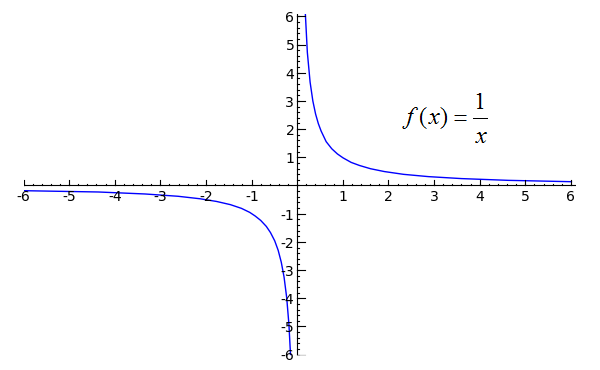MA441- LEC 3 - The limit of a function II
Goal
- one-sided limits
- inifite limits
- vertical asymtote(s)
Example 1. (Jump)
Let \( f(x)=\frac{|x|}{x} \). Find \(\lim_{x\to 0} f(x)\)
Therefore there is no limit at \(x=0\).
But we can define one-sided limits.
Left-handed limit
\[\lim_{x\to x_0^-} f(x)=L\]
we say the limit of \(f(x)\) as \(x\) approaches \(x_0\) from the left is equal to \(L\) if we can make the values of \(f(x)\) arbitrarily close to \(L\) by taking \(x\)'s to be sufficiently close to \(x_ 0\) and \(x\) is less than \(x_0\).
right-handed limit
\[\lim_{x\to x_0^+} f(x)=L\]
we say the limit of \(f(x)\) as \(x\) approaches \(x_0\) from the right is equal to \(L\) if we can make the values of \(f(x)\) arbitrarily close to \(L\) by taking \(x\)'s to be sufficiently close to \(x_0 \) and \(x\) is greater than \(x_0\).
Now let's find
\( \lim_{x\to 0^-} f(x)=? \)
and
\( \lim_{x\to 0^+} f(x)=? \)
proposition.
\[ \lim_{x\to x_0} f(x)=L \]
is equivalent to
\( \displaystyle \lim_{x\to x_0^-} f(x)=L \) and \( \displaystyle \lim_{x\to x_0^+} f(x)=L \)
Why do we need a rigorous definition of the limit of a funciton.
Let \(f(x)=x^2\cdot cos(\frac{\pi}{x})\). Find \(\lim_{x\to 0} f(x)\).
Check up

\(f(-4)=?~\), \(\displaystyle \lim_{x\to -4^-} f(x)=?~ \), \(\displaystyle \lim_{x\to {-4}^+} f(x)=?~\), \(\displaystyle \lim_{x\to {-4}} f(x)=?~\)
\( f(1)=?~\), \(\displaystyle \lim_ {x\to 1^-} f(x)=?~ \), \(\displaystyle \lim_ {x\to 1^+} f(x)=?~ \), \(\displaystyle \lim_ {x\to 1} f(x)=?~ \)
\(f(6)=?~\), \(\displaystyle \lim_ {x\to 6^-} f(x)=?~ \), \(\displaystyle \lim_ {x\to 6^+} f(x)=?~ \), \(\displaystyle \lim_ {x\to 6} f(x)=?~ \)
infinite limits
Example.
Find \( lim_{x\to 0} \frac{1}{x^2} \) if it exists.

From the graph,
\[ \lim_{x\to 0} \frac{1}{x^2}=\infty\]
Example.
Find \( lim_{x\to 0} \frac{1}{x} \) if it exists.

From the graph, \[ \lim_{x\to 0^+} \frac{1}{x}= \infty ~~ lim_{x\to 0^-} \frac{1}{x}=- \infty \] Therefore, the limit does not exist at \(x=0\).
Vertical asymptote \( x=a \) of the curve \( y=f(x) \).
if at least one of the following statements is true:
- \[ \lim_ {x\to a^+} f(x)=\infty \]
- \[ \lim_ {x\to a^+} f(x)=-\infty \]
- \[ \lim_ {x\to a^-} f(x)=\infty \]
- \[ \lim_ {x\to a^-} f(x)=-\infty \]
Example.
Find \[ \ds \lim_{x\to 3^-} \frac{2x}{x-3}\] and vertical asymptote(s) of \( y=\frac{2x}{x-3} \).